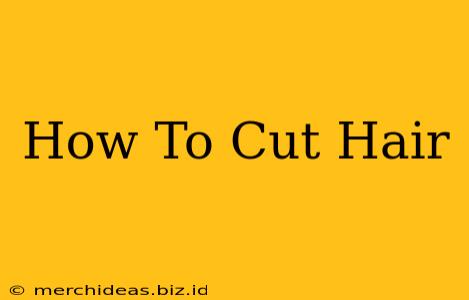Cutting your own hair might seem daunting, but with the right tools and techniques, you can achieve a surprisingly good result. This comprehensive guide will walk you through the process, from preparing your tools to achieving various hairstyles. Whether you're aiming for a simple trim or a more dramatic change, we've got you covered.
Preparing for the Cut: Gathering Your Tools and Setting the Stage
Before you begin, ensure you have the right tools. Improper tools can lead to uneven cuts and frustrating results. Here's what you'll need:
- Sharp Hair Cutting Scissors: These are crucial. Dull scissors will cause split ends and an uneven cut. Investing in a good pair of hair cutting shears is a worthwhile investment. Don't use regular scissors!
- Hair Clips: These will help section your hair for a more controlled cut. Sectioning is key to achieving an even look.
- Comb: A wide-tooth comb is ideal for detangling and sectioning.
- Spray Bottle: Keeping your hair damp throughout the process will help maintain control and prevent unevenness.
- Mirror: Ideally, you'll want two mirrors – one regular and one hand-held – for better visibility.
- Optional: Hair Cutting Cape: This will protect your clothes from stray hairs.
Basic Hair Cutting Techniques: From Trims to Layers
There are several techniques for cutting hair at home. Let's explore a few:
Trimming Split Ends:
This is the easiest cut to attempt at home. Focus on small sections at a time. Hold each section taut and carefully snip off only the very ends of the split hairs. Avoid cutting too much!
Blunt Cut:
A blunt cut involves cutting the hair straight across. Start by sectioning your hair and carefully combing each section. Hold the section taut and cut horizontally across. For an even cut, it's helpful to use your fingers as a guide, holding them parallel to the line you are cutting.
Layered Cut (Advanced):
Layering requires more skill and precision. It's best to start with small sections and work gradually. Use point-cutting (cutting with the tips of the scissors) to create softer layers. Be cautious and take your time, as it's easy to make mistakes.
Different Hair Types and Cutting Considerations
Your hair type significantly impacts the cutting technique. Here's what to consider:
- Fine Hair: Fine hair requires a lighter touch to avoid thinning it too much. Avoid taking off too much length at once.
- Thick Hair: Thick hair can be more challenging but allows for more styling versatility. Ensure you section your hair effectively and use sharp scissors.
- Curly Hair: Curly hair is best cut when dry. Cutting wet curly hair often results in shorter, uneven lengths once it dries. Use a diffuser when drying to maintain curl definition.
Post-Cut Care: Maintaining Your New Style
After you've cut your hair, proper care is essential to maintain its health and appearance:
- Deep Conditioning: A deep conditioning treatment can help replenish moisture lost during the cutting process, particularly if you've trimmed split ends.
- Regular Trimming: Regular trims (every 6-8 weeks) are crucial to prevent split ends and keep your hair looking its best.
- Use the Right Products: Choose hair products suitable for your hair type. This could include shampoo, conditioner, and styling products.
When to Seek Professional Help
While cutting your hair at home can be satisfying, there are times when it's best to leave it to the professionals:
- Complex Styles: For intricate styles or significant changes, a professional hairstylist is recommended.
- Uneven Results: If you're unhappy with your at-home cut, a stylist can help correct any unevenness.
- Significant Hair Damage: If your hair is significantly damaged, a professional can assess the damage and provide appropriate treatment.
This guide provides a starting point for cutting your own hair. Remember practice makes perfect! Start with small adjustments and gradually increase your skills. Good luck, and happy cutting!
